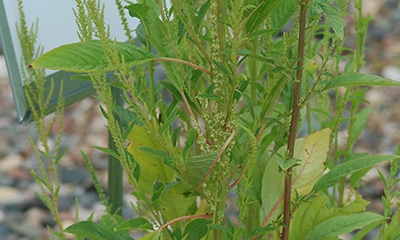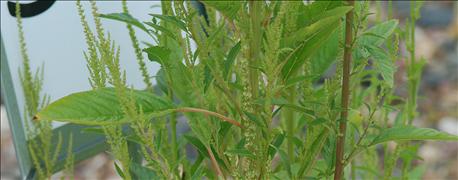March 27, 2016

Were you satisfied with waterhemp control in your soybeans last season?
If not, it’s time to consider a new strategy, says Bryce Nelson, a certified crop adviser and owner of Advantage Crop Consulting, Rose Creek.
In the April issue of The Farmer, he discusses how herbicide-resistant waterhemp is widespread.
“In southern Minnesota, we assume that most waterhemp populations are resistant to glyphosate, as well as ALS herbicides such as Pursuit and First Rate,” he says. “In addition, some waterhemp populations in the state have developed resistance to PPO-inhibitors such as Valor, Flexstar and Cobra.”

Layer residual herbicides to extend waterhemp control
Nelson says one trait that makes waterhemp a formidable competitor is its extended emergence pattern. In Minnesota, waterhemp seedlings start emerging in late May and keep coming until August, especially in 30-inch soybean rows. The peak emergence period is typically the first two weeks of July, often outlasting the residual control provided by preemergence herbicides.
One way to extend control longer into the season is to layer, or overlap, soil-applied residual herbicides, he says. In this strategy, a pre-plant or pre-emergence residual is followed by a second residual herbicide application about 30 days after planting.
He cites University of Minnesota research that shows by layering a residual in early June, you can extend control until canopy closure.
Layering residual herbicides is not a new tactic, but it’s being talked about more often as glyphosate-resistant weeds proliferate, says Fritz Breitenbach, U-M Extension integrated pest management specialist. In 2015, U-M researchers demonstrated the effectiveness of this strategy for season-long control of waterhemp in soybeans.
The trials, funded by the Minnesota Soybean Research and Promotion Council, evaluated three soil-residual herbicides:
•Dual II Magnum (s-metolachlor)
•Outlook (dimethenamid-P)
•Warrant (acetochlor)
•The herbicides were applied preemergence (PRE) only, or as PREs followed by an early post emergence (POST) application at V2 - V3.
•Full rates were applied, based on soil type and seasonal limits.
The three herbicides, all Group 15 products, were chosen because of their effectiveness for controlling waterhemp and their flexibility of application timing, Breitenbach says. Group 15 herbicides also have shown durability over many decades with just one resistant weed species. However, overreliance on Group 15 products can lead to more resistant species, he adds.
The research found that with a PRE treatment only, control of glyphosate-resistant waterhemp dropped sharply by late June, just as the peak emergence period began. By contrast, layered or PRE/Early POST applications of a soil residual provided 90% - 95% control through September. That’s compared to 62% - 81% control with a PRE only.
Better waterhemp control led to higher soybean yields, which increased 6 to 14 bu./acre in the layered treatments.
Nelson says that clients he works with have found that this layering tactic works very well for control of waterhemp in soybeans.
“In no-till or strip-till fields, I recommend using Sharpen (salflufenacil) in the burndown for broadleaf control plus residual activity on waterhemp. Follow with an early postemergence treatment of Dual II Magnum, Outlook or Warrant, tank-mixed with Flexstar GT (fomesafen + glyphosate),” he says.
“In conventionally tilled fields, my clients have seen very good results with a preemergence application of Authority products (sulfentrazone), Boundary (s-metolachlor + metribuzin), or Optill (saflufenacil + imazethapry), followed by a timely postemergence application of Dual II Magnum, Outlook or Warrant mixed with Flexstar GT.”
The precise timing of the second soil-residual application will depend on what products you spray, the stage of soybean development, moisture and environmental conditions, and label restrictions.
There is a window of 21 to 45 days after planting, Breitenbach says. However, it is better to be on the early side than the late side.
Remember that soil-applied herbicides require moisture for activation. If the soil is dry, a program of overlapping residuals is recommended. In a dry environment, these chemicals degrade quite slowly, so herbicide will still be available in the soil when you do get moisture and weeds start germinating.
You May Also Like




